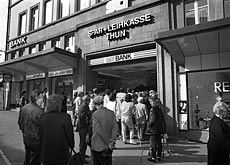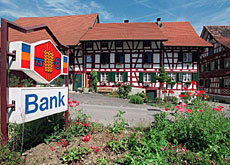Thun bank collapse is finally settled

A Thun regional bank has been liquidated 14 years after it went bust, depriving over 6,000 depositors of more than a third of their savings.
The Savings and Loan Bank in Thun (SLT) was forced to close down in 1991 to the consternation of the Swiss banking world. Its closure led to major changes in the financial landscape.
Nearly SFr900 million ($685 million) has been returned to creditors but a further SFr233 million will not be paid out, said the liquidators.
The bankruptcy affected some 5,000 small creditors. Large creditors included the Swiss Bankers Association.
The liquidators said that a number of those owed money could not be reached to receive a settlement.
They added that unclaimed money would eventually be transferred to the town of Thun as well as to the local authorities in Spiez and Saanen, which were left to deal with a number of hardship cases caused by the bank’s collapse.
Sea change
The Swiss Federal Banking Commission’s decision to close SLT branches and cash machines on October 3, 1991 sent a shudder through the banking sector.
It led to a new law on bank insolvency and increased depositor protection.
The move also speeded up restructuring of regional banking. The sector’s umbrella organisation put together a new concept with the motto “autonomous in the front, cooperation in the back office”.
It founded a new association called RBA-Holding, which was to oversee the restructuring efforts of member banks.
“The regional banks could remedy their structural weakness with the help of the umbrella organisation,” Professor Beat Bernet of St Gallen University said.
According to analysts, thanks to this new way of doing business, the banks were able to weather the storm.
Hans Geiger, a professor at Zurich University, called the concept a “good achievement”. “The banks did their homework,” he added.
Less drama
Bernet stressed that one could never rule out the collapse of a bank.
However, should such an event take place today, “the consequences for the customers would be less dramatic”.
One change in the law after the collapse of the Thun bank was that deposits up to SFr5,000 would be paid out immediately in the event of a bank’s liquidation.
Also the culture of risk management had developed since the 1990s.
The Banking Commission has increased its supervisory role, according to Bernet.
“Today the Commission without a doubt employs a much stricter regime with the small banks,” he said.
swissinfo with agencies
The Federal Banking Commission closed the counters and cash machines of the SLT, a regional bank in Thun on October 3, 1991.
The bank’s assets could not cover outstanding liabilities.
The bank’s collapse hit some 6,300 depositors the hardest – the liquidation is complete but they will only get 60 per cent of their money back.
The SLT’s closure was precipitated by falling property prices and was followed by a regional banking crisis.
Nearly half of the country’s 200 regional banks did not survive the crisis and were taken over by big or cantonal banks or merged within their own group.
The crisis was resolved without financial assistance from the government.
The Federal Banking Commission estimated that the losses incurred by Swiss banks on their loans between 1991-96 amounted to SFr42 billion.

In compliance with the JTI standards
More: SWI swissinfo.ch certified by the Journalism Trust Initiative

You can find an overview of ongoing debates with our journalists here. Please join us!
If you want to start a conversation about a topic raised in this article or want to report factual errors, email us at english@swissinfo.ch.